From Denver, Colorado comes Bowen Customs, manufacturer of all-aluminum, fully-welded truck bed systems fusing flatbed function, storage, and jaw-dropping style. With high departure angles, sealed storage, and tons of options, Bowen Customs is refining what a truck bed can be.
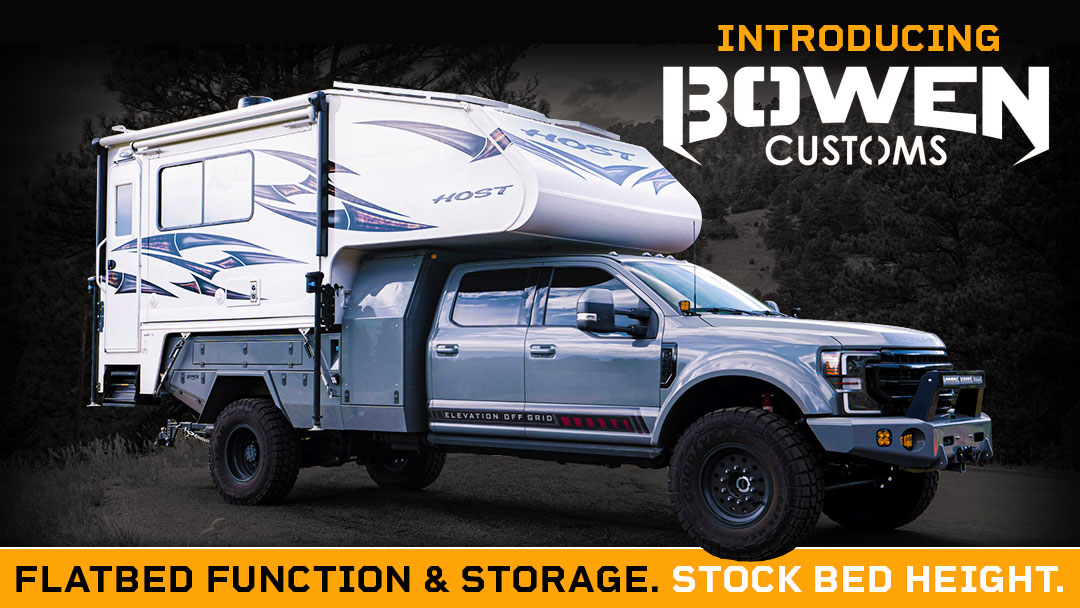
The speed at which Bowen Customs has established itself as the go-to custom truck bed builder for the truck camper market is simply remarkable. The Denver brand officially launched just four years ago at Overland Expo Mountain West 2021. Walking around that same event this past August, Bowen Custom beds were everywhere, and on many of the most impressive truck camper rigs at the show. How is this possible?
In total honestly, the rapid rise of Bowen Customs even caught us off guard. While we had noted the beautifully laser cut Bowen logo in an increasing number of rigs at Overland Expos, it took a couple truck camper industry leaders to state the obvious. Bowen Customs has gone from newcomer to aspirational brand in two shakes of a turnbuckle. How is this possible?
Anyone who’s been successful in business knows there’s a certain amount of luck and timing involved. That stated, there’s no doubt that Bowen Customs hit the market with a visionary product that’s taken aluminum truck bed systems to another level—especially in aesthetics. For such a young company to have such a signature look so fast is striking, to say the least. How is this possible?
All of this ignores the most important feature of a Bowen Custom truck camper bed—flatbed function and storage at the factory bed height. The unique Bowen design eliminates the raised center of gravity and taller camper entrance that plagues a standard flatbed design. This approach also keeps a rig’s overall height down and the space between the truck cab and cabover tight. How is this possible?
We’re going to let Brent Bowen, Founder and CEO of Bowen Customs answer our repeated question, but we’ll give you a few tantalizing hints: he’s eaten his fair share of dirt and sand behind a sand rail, wrenched on his fair share of cars, trucks, and campers, and earned a degree in Aviation Science, a pilot’s license, and attended ministry school. That’s right, he’s a pilot! And if you think you know how Bowen happened, think again. This is not your typical start up story.
Okay, Brent, how is this possible?
Click here for a Bowen Custom bed brochure.
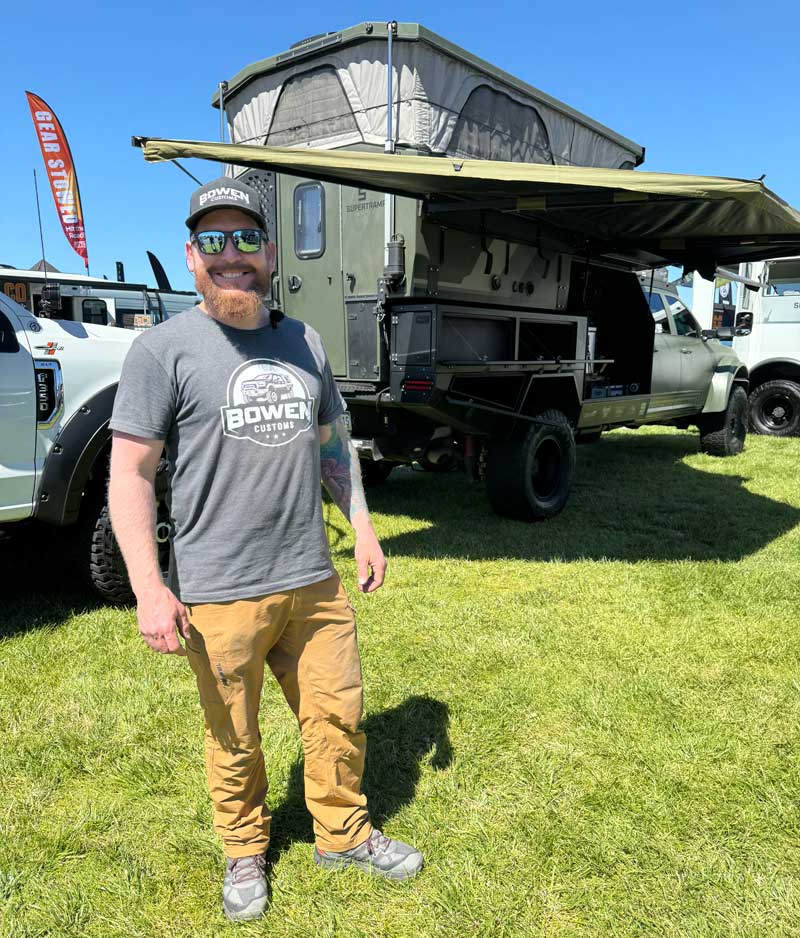
Above: Brent Bowen, Founder and CEO of Bowen Customs
What’s your background before starting Bowen Customs?
I’ve been into vehicles, camping, and off-roading my whole life. I grew up in southern California and was in the 4×4, Baja racing, and sand rail scenes, which are big there. My Dad said that I was born with a wrench in my hand as I was always taking things apart and, eventually, putting them back together. I built my first car with my Dad at age 13 – a Meyers Manx dune buggy replica. That’s how I got my start in building and fabrication.
As I was getting my college degree, I was also going to trade school at night to learn how to fabricate and weld. This is where I took my fabrication hobby and turned it into a legitimate and professional-grade skill.
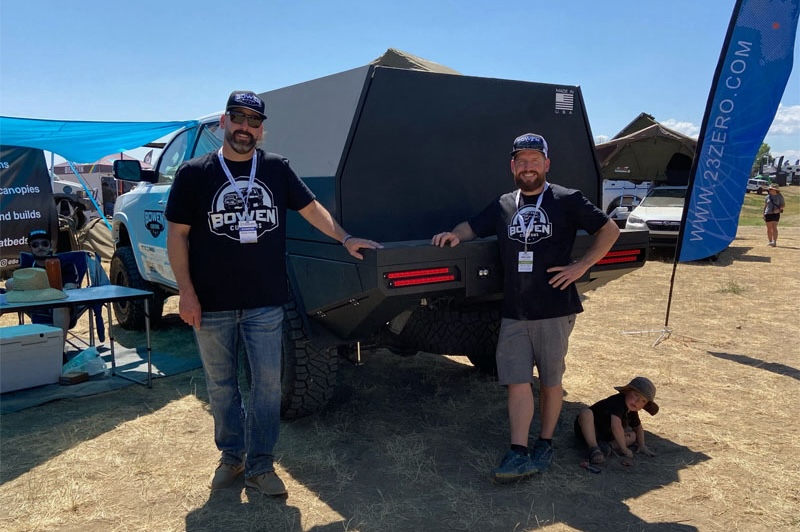
Above: Jason and Brent Bowen
Fast forward many years to 2018, and my brother had a business that needed some custom work done on a flatbed. As a side hustle, I took it on and helped him with the project. The next year, he needed a couple more flatbeds done, and I found my side hustle taking up a significant amount of time and requiring a lot more of my attention. That’s when Bowen Customs became a thing.
Those projects were standard commercial flatbeds, which you would see on contractor trucks. At that point, the overland space was what we did for fun. We were watching aluminum truck beds being imported from Australia with this unique look and design for off-road applications. We wondered if there would be a market for this same style of off-road flatbed, but made in the USA. That’s when we said, ‘what the heck’ and gave it a go.
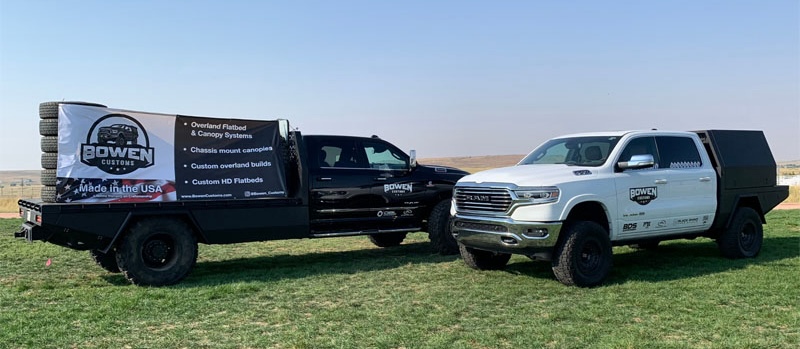
We built two beds and mounted them on two trucks (shown above) and debuted them at Overland Expo Mountain West—in Colorado—in 2021. It took off from there. That’s what led us to this point.
What’s your college degree in? It’s not like there’s a custom truck bed major.
My main focus was Aviation Science. That was my career plan in college. I majored in Aviation Science, got my private pilot’s license with an instrument rating, and was working on my commercial pilot’s license when I decided to shift.
That’s quite the pivot from becoming a commercial pilot to building custom truck beds.
If you want it to sound even funnier, I went to ministry school as well (laughs). I also have a professional background in engineering. I’ve done quite a few things in my time.
Does it feel like everything led to Bowen Customs, or is that just how life worked out?
That’s a great question. There are definitely elements that feel like they were meant to be. Was my time in college, my time in aviation, my years in the work force learning how to be a leader and work with people, and my time in engineering learning how things work, leading up to this? Yeah, I think a lot of things in my past led to this point. Had I not done those things, Bowen Customs would not have been as successful, or at least not as successful so quickly.
Tell us about those first builds and what they meant to Bowen as a company.
Our original builds were inspired by the Australian companies like Norweld and PCOR. We made sure our designs were inspired, but not copying those manufacturers. For example, our taillight design and overall aesthetic are unique to us. Our goal was to have a unique product in that same segment.
The first truck bed we showcased was on my Ram 1500 short bed. We put a flatbed on the truck with a canopy on the back—nothing fancy on the inside. The other set-up was a Ram 4500 chassis cab with a gigantic 12 foot long flatbed. Both had our lower boxes and the aesthetics that our beds are known for today.
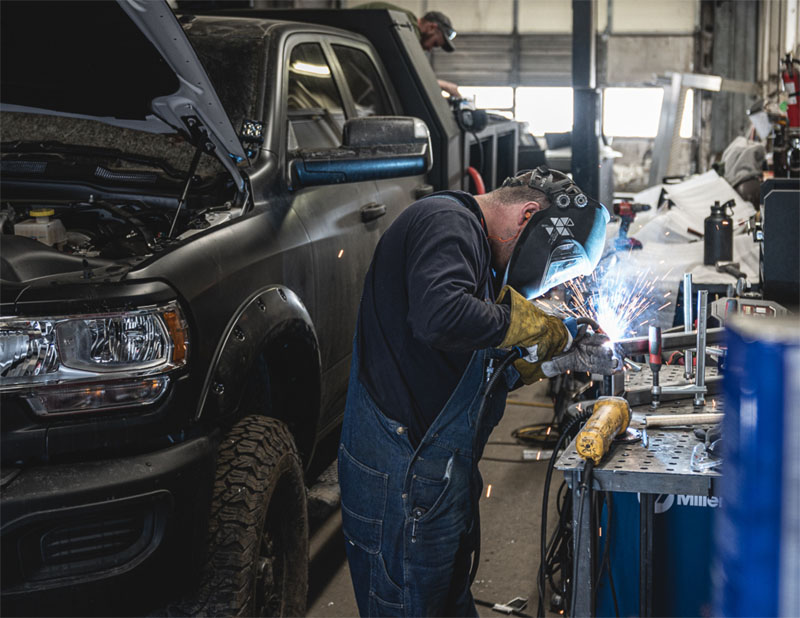
Are all your beds built in-house?
Yes. Not only do we use all our own designs, but we build them 100 percent here in Colorado. We source only from US foundries. Some of the core materials for aluminum aren’t found in the USA, but we use US foundries and source as much as we can in the United States.
What does the Bowen Customs production process involve?
We start with our CAD files for the specific model we’re making. We have exponentially more skews than our closest competitor. That’s where the custom comes in. All of our builds are unique to the specific model of truck.
So we take our CAD files and start the laser process. All of our aluminum is laser cut for a clean finish. Then everything is CNC-formed for the specific shape needed for the product. Then everything that is seen is TIG-welded by hand—no robots. Then some things, like the deck and structural components under the truck, are MIG-welded.
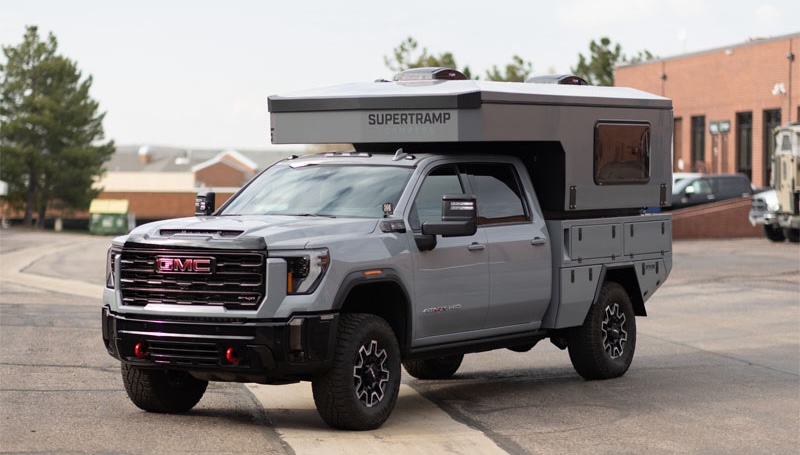
Above: A Supertramp Flagship LT and color-matched Bowen Custom bed
Once the welding is completed, everything is checked for imperfections. When all the raw components have been fabricated, checked, and prepped, they go to powder coat. Powder coat ranges from our standard black to full custom color matches. Some beds even get color-matched painted if they’re going into an Elevation Off-Grid truck. We don’t do that part, but they do.
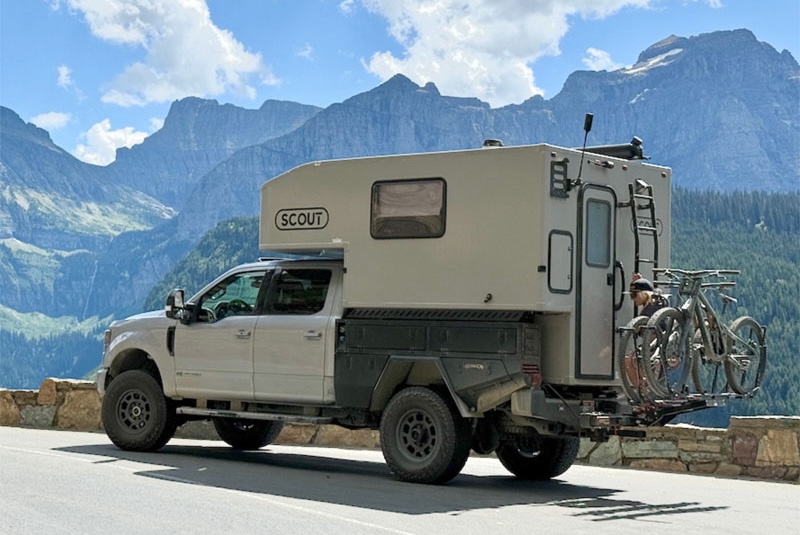
Above: A Scout Kenai and Bowen Customs bed
Once powder coating is complete, we begin our assembly process. We have assembly bays where each truck has a detailed build sheet on how that specific bed comes together and the features and accessories it gets. Our team assembles the bed in those bays.
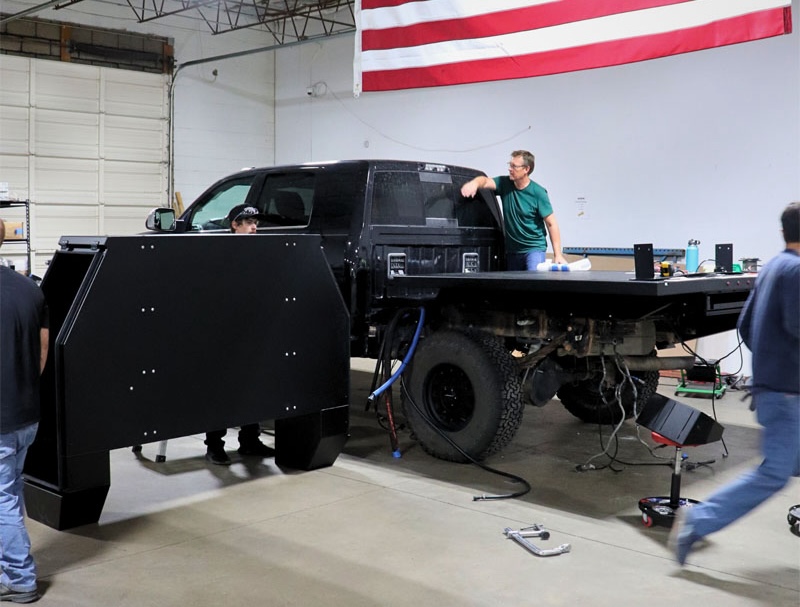
Once the assembly is complete, it moves to the install bay. At this point, the customer has dropped off their truck and we’ve removed their factory bed—if they had one—and any electronics that go with it. Then we begin the installation process of our bed. That involves prepping the truck fuel and electrical systems, and installing the bed itself.
Once the installation is complete, we have a very thorough quality control process. We check all the bolts holding the deck down, we check all the seals, we check all the latches for proper compression, we QC the lights and make sure they’re functioning properly, and any accessories that go with it.
At that point, if the customer has brought us their camper or topper, we install the camper or topper, tie it down, and make sure fitment is correct. The next step is handing the keys to the customer and sending them off on their adventure.
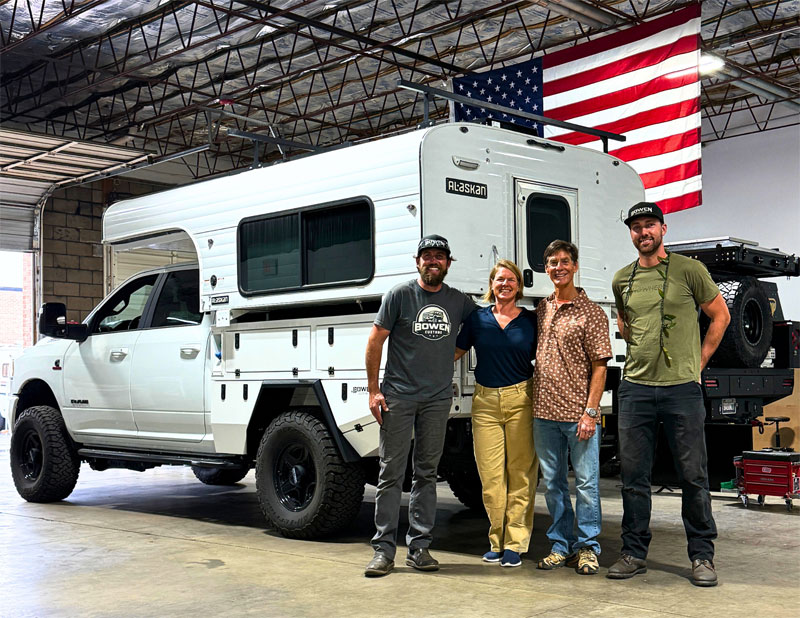
Above: Customers take delivery of a Bowen Customs bed with an Alaskan Camper
That’s quite the process. When did you make the leap to CAD, CNC and laser cutting?
The first box and taillight—which is our signature look—was built by hand. We were cutting and bending the aluminum with basic hand tools, welding it up, and grinding it down. It took us two weeks to build the first bed.
When we had the look and feel of our bed down, we took it to another shop down the street and they modeled it into CAD. They had all the machinery and really helped us get off the ground.
From there, it was gradual growth. We had basic machinery and a small shop that we could fit two trucks in. We were a small fabrication shop then, versus the manufacturing company we are today. All of our growth has been over the past four years.
Did you have outside funding?
No. We bootstrapped everything with our own money.
We moved in 2022 into a 4,400 square foot facility. We almost didn’t get it because we thought it was too big. Within six months, we added the building across the parking lot. Now we’ve added the building next to us. We’re at about 12,000 square feet, with additional outside storage.
Along the way, we’ve added new equipment bit by bit. We make do with what we have until we can afford the next best thing. You can get around not having the perfect machine if the quality of the product is there, and you’re taking care of the customer.
Why did you choose aluminum as your core material?
First, for weight. We all know aluminum is lighter than steel. And second, to avoid rust. There’s no rust in aluminum. Yes, aluminum can oxidize and corrode. It’s a much slower process, especially if it’s properly coated with powder coat. That’s why we don’t sell raw aluminum beds. We don’t do raw because powder coat helps protect the lifespan of the product.
Our non chassis cab beds are 100 percent aluminum. The only thing that’s steel on those beds is the stainless steel hardware. That’s our flatbeds, our canopies, our camper beds, and our topper beds.
When you get to our chassis cab line, all of the boxes and everything you see on a truck are aluminum with the same construction, but we have a steel sub-frame underneath them. We do that because the chassis cab customers are typically using larger hard side campers. And a large amount of those customers opt for our torsion-free sub-frame.
What is a torsion-free sub-frame?
The torsion-free sub-frame is a pivoting frame that pivots independently from the frame of the truck. It doesn’t allow any torsional transfer from the truck into the bed or into the camper. That’s why the chassis cabs have a steel sub-frame.
Aluminum framed composite campers like Host and Lance don’t require this, but the torsion free system is a critical requirement for full composite campers that are bolted to the bed. This is a very common European style of camper and has been around for many years.
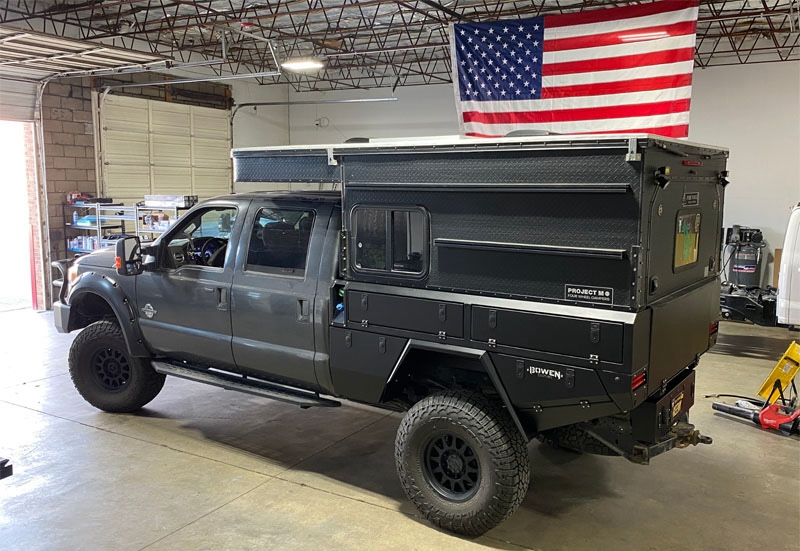
Above: A Four Wheel Camper Project M and Bowen Customs bed
How do you maximize storage without compromising structure or weight?
One of the advantages we have in this market is that we’re not adapting a contractor bed to fit a camper. There’s nothing wrong with that. A lot of DIY people use that approach.
We started as an overland product. From the time we introduced the first two beds at Overland Expo, they were designed to be paired with off-road canopies and then campers. Everything about our designs has been done with the camper in mind. Knowing that, we’ve always had weight as a consideration. It was never an afterthought.
The shape and dimension of our boxes are kind of like carving a statue out of a block of marble. There are specific parameters and dimensions we have to fit within. There really are only a couple of ways to do it right, have it work with all the different types of trucks and campers, and stay within the weight limits of the vehicles.
There is a lot of behind-the-scenes communication with the customer. Before we build a bed, we have extensive conversations with the customer about their truck, camper, and what they might upgrade to in the future. There’s a lot that goes into making sure we get the formula correct and that the final bed is the perfect setup for them.
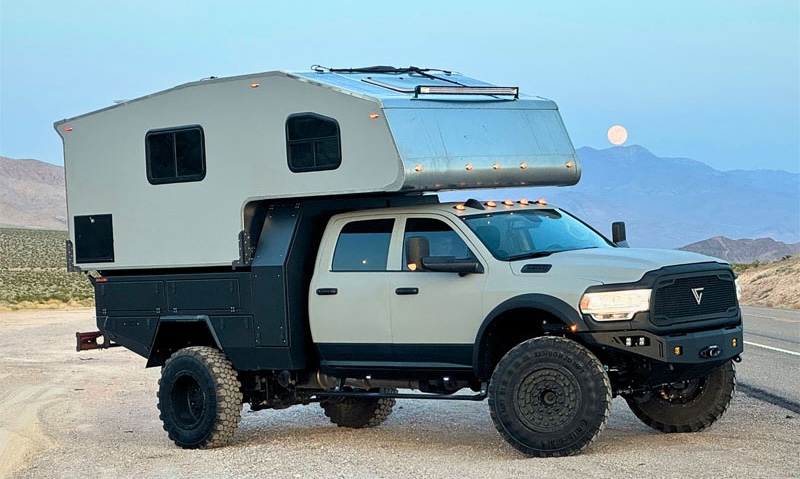
Above: A Kingstar truck camper and Bowen Customs bed and garage
How does a Bowen bed compare in weight to a factory bed?
It all depends on the truck, the product they are getting from us, and the accessories.
We have some flatbeds that are actually lighter than the factory beds. For example, a Ram or Chevy bed is made from steel. Right off the bat, an aluminum flatbed with no upper boxes is going to be lighter. At the other end of the spectrum, a chassis cab with our steel sub-frame is considerably heavier because it needs to accommodate a much heavier load.
Your average customer will come to us with a factory bed that weighs between 400 and 500 pounds. If they were to get our camper bed—which is our most popular product—without a garage, it will be in the 500 to 600 pound range. With a garage, it’s in the 700 to 750 pound range, depending on the truck model.
So our average customer will have a net weight gain of 100 to 200 pounds.
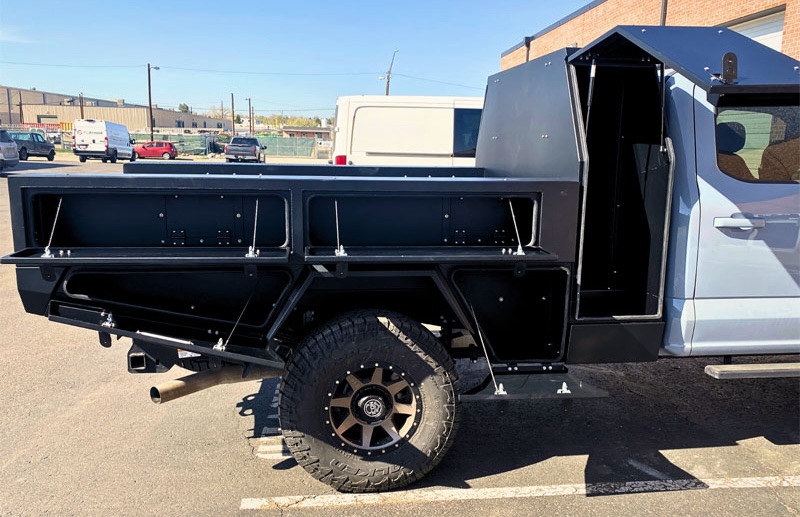
What problems do your beds solve for truck camper owners?
The camper bed is what’s solving the most problems. The first answer is the storage. The external storage is a game-changer.
The biggest thing we hear from traditional slide-in customers is that they want more exterior storage. Before getting a Bowen bed, things like chairs and fishing poles ended up in the back seat area of the truck in a jumbled mess, or on the main floor area of the camper in the walkway.
That’s fine, and it’s worked for as long as campers have existed, but the outside storage on our Bowen beds gives all that stuff a home. Those items can live there year round. All that stuff is now moved and out of the way into a permanent location.
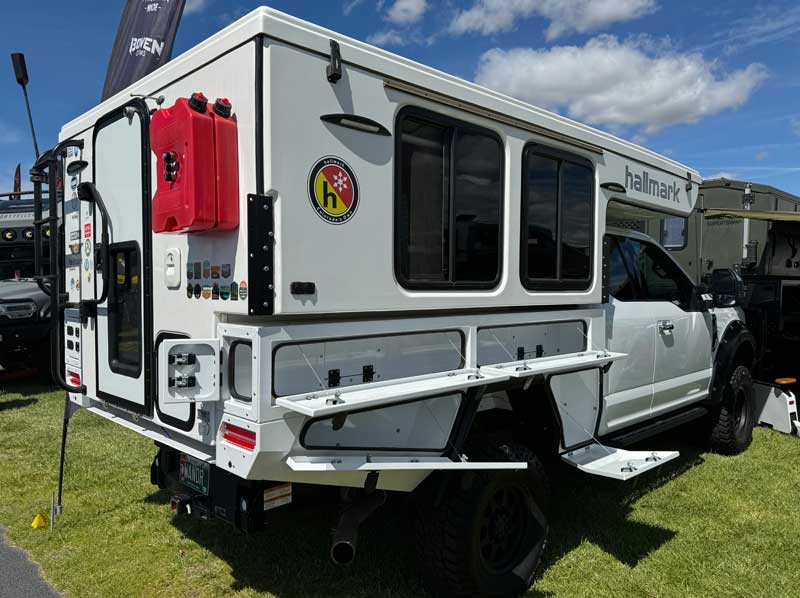
Above: A Hallmark Guanella and Bowen Customs bed—aka the “Stormtrooper”
We have customers set up their side boxes with full galley kitchens that have stoves on one side and full tool areas on the other. It’s the functional storage that people love.
The other important thing—and it’s something we have a patent-pending on—is that our camper bed retains the factory floor height. That’s extremely important to keep the center of gravity as low as possible, and keep the gap from the roof of the truck and the camper cabover as low as possible.
If you put a truck camper on a flatbed, that camper is now 7 to 10 inches higher. Now your entry door, center of gravity, and overall height are higher. And you have a 12-inch gap over the roof of your truck. That was the number one problem that we solved; retaining the factory bed floor height.
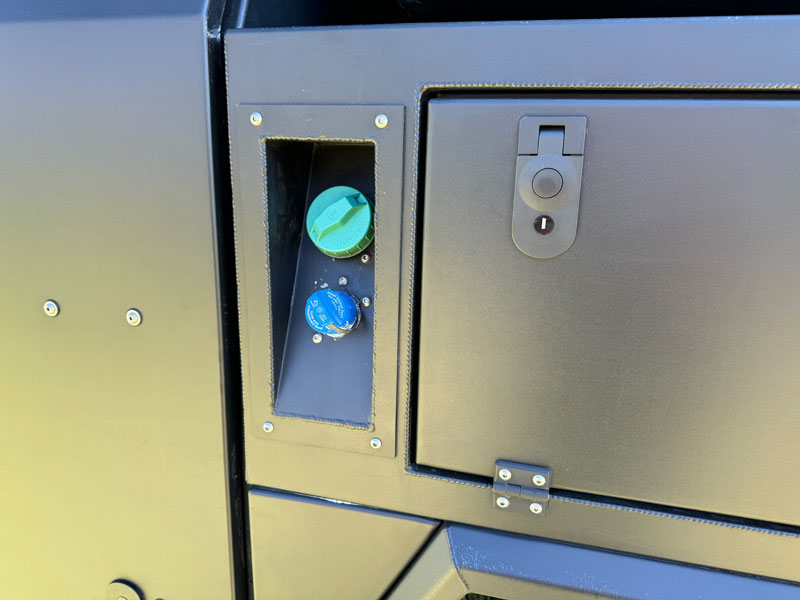
Above: A Bowen Customs bed with diesel fuel and DEF fills
How do you address tricky fitment challenges like jack leg clearance or fuel doors?
That’s a very good question. A lot of that comes from learning what doesn’t work. In the early years, there were more times than I care to count that we’d fit the camper and there was a clearance issue. There was a lot of trial and error in the early days.
At this point, we know what to look for and we know what the pain points are. We get out in front of them and figure them out from the start. Jack clearance is a big one. Tie-down points are a big one, especially in the larger campers. If you have a 6,000, 7,000, or 8000 pound camper, we can’t play with the tie-down points. We have to use the factory tie-down points as the manufacturer intended. We work with those elements.
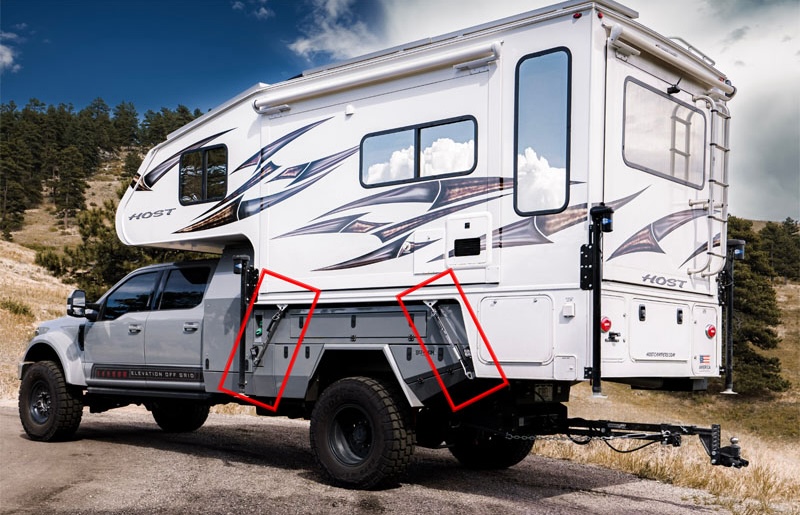
Above: A Host truck camper, Bowen Customs bed with garage, and Torklift tie-down, turnbuckle, and towing systems
Are your beds compatible with Torklift tie-down and turnbuckle systems?
Yes, we do a ton of Torklift systems. This is part of our fact-finding mission with a new customer. We find out what truck, camper, and tie-downs they have or want. Then we get pictures and measurements. From that, sometimes we only have one design option. For example, if you’re putting a Host on a chassis cab, there’s only one design option for the tie-downs. Sometimes there are multiple options and we’ll present the options to the customer with our recommendation.
We also do a lot of internal tie-downs with the smaller campers.
What’s the weight limit of your truck beds?
It depends on the application. The chassis cabs have a steel subframe that we mount in various ways to the truck frame. That system is bulletproof. It can handle any camper you load. We source a specially modified pivot through Globe Trekker Overland and incorporate it into our subframe. It’s rated to 14,000 pounds. I’d rather over-engineer a product than lose sleep over it.
For the non chassis cab builds that are 100 percent aluminum without the steel sub-frames, we studied how the OEMs—Ford, GM, Ram, and Toyota—build their beds and mimicked their design and then beefed it up. The OEMs spent hundreds of millions designing their beds over the years. If their factory bed can handle the weight, then our custom bed can handle the weight.
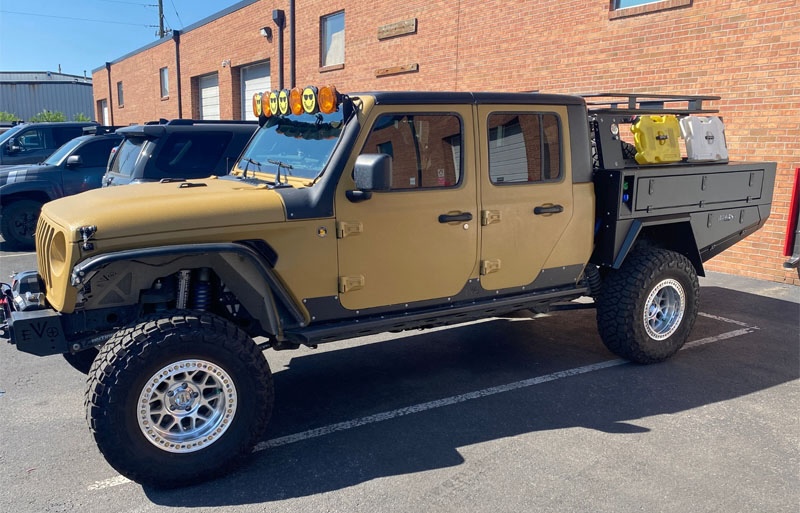
Can you build beds for any truck?
Great question. We definitely have our production models, including full and mid-size trucks from Ford, Chevy, Ram, and Toyota. That’s what we see 99 percent of the time. We have production model beds to fit these trucks, and a lot of variations, including with and without our garage. We do those day in and day out.
After that comes the more custom side of things. Custom can be as simple as having a Nissan Titan, which we don’t get requests for often. We don’t have a production bed for that truck, but we could build a bed to fit that truck. We start with the CAD model that we have that is as close as possible to that model, and then modify it. There’s a fee and a longer time commitment, so we can do that CAD process. That’s the entry into our custom process.
Then there’s full-blown custom. For example, we have a customer coming in with a 1979 series Land Cruiser from Australia. We’ve done one 6×6 truck, and another is arriving later this year. That’s very custom. We have a customer with an FJ45 Land Cruiser we’re doing a custom bed for.
So yes, we can do almost any truck. The question is how feasible a custom bed is for that truck, and how interested we are in the project. If you bring in a 1960s Power Wagon or a classic Toyota, that’s the kind of fun project we enjoy working on.
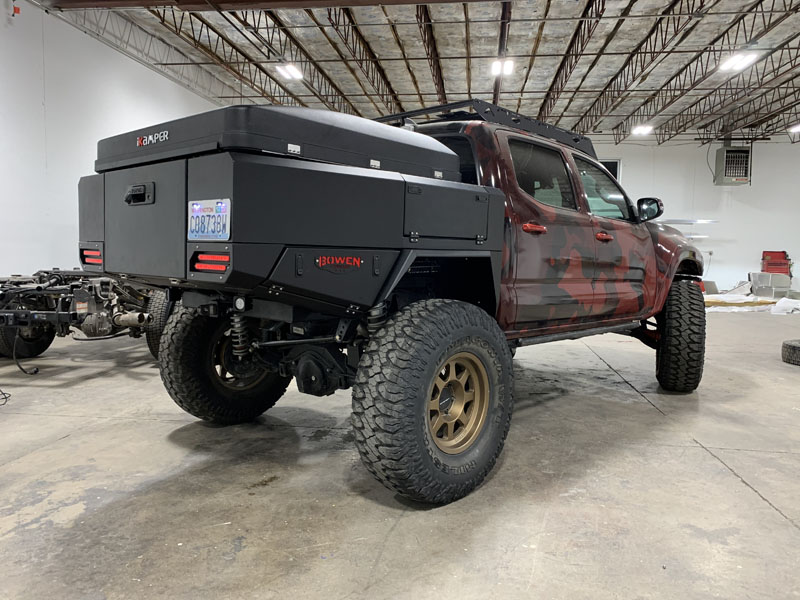
How do you ensure the bed fits both the truck and camper properly?
It depends on how familiar we are with the truck and the camper. If you bring us a 2024 Ford F-350 and say you’ve got a Scout Kenai, we’ve done that combination so many times we know exactly what needs to be done.
If we’re doing a custom and one-off truck, we don’t know what we don’t know. That’s when we require the truck to be on-site for longer. For custom builds like that, we’ll pre-assemble the bed before powder coating and do a test fit on the truck to make sure everything fits. Then we can see if there are any modifications that need to be made. We’ll make any needed changes, disassemble the bed, and powder coat. That’s how we guarantee fit on something less common.
If you have a rare camper, like a 1960s Avion, we’re going to send you a PDF requesting dimensions on that camper. That way, we’ll know if we’re going to need an extra mat or spacer, or if there’s any other question on fitment. If there’s any question, we’ll ask the customer to bring us the truck and/or camper.
How does a customer bring you a truck and camper if they don’t currently have the bed?
Most slide-in customers have their factory pickup bed. When they show up, we remove the factory pickup bed and install our bed.
For flatbed customers, we’re typically installing the flatbed without the camper. Then the customer goes to the camper manufacturer for the camper installation.
We try to over communicate with the customer and the camper manufacturer to address any potential issues up front. For example, I can’t tell you how many Four Wheel Camper flatbeds we’ve done, so we know exactly what needs to be done for those campers. We tell whoever is doing the install to do X, Y, and Z to get the camper installed properly.
We always get ahead of things and talk to the manufacturers about how they plan to mount the camper. We have a talented team that solves problems before they become problems.
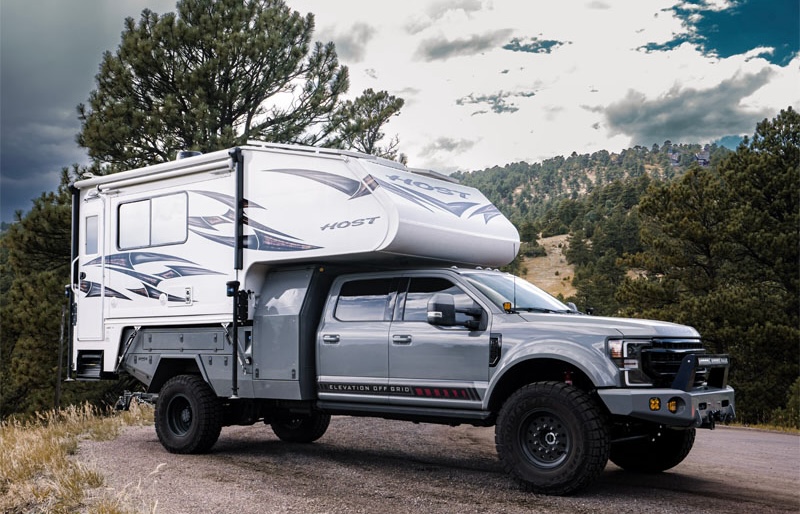
Above: A Host triple-slide truck camper and Bowen Customs bed with garage
Can you build beds for side-entry campers?
Yes. For example, the side entry flatbed FWC Hawk models or the Rugged Mountain flatbed models are mounted to our traditional flatbeds. We do side entries all the time.
For the side-entry slide-in campers from Lance or Host, we mimic the design of the factory truck bed. Our bed stops in the same place that a dually F-350 or 3500 pickup bed stops. So if you took a Host or a Lance with the side entry, and slide it out of an F-350 or 3500, and slide it into our Bowen bed, that side-entry camper still functions as designed.
“For customers who come to Bowen Customs, we want to be their Ferrari.”
Is it fair to say that Bowen Customs is aiming at the high-end of the market?
Yes. And I say this with humility. As far as the off-road overland market is concerned, we have the best bed replacement on the market. We have a patent pending on our floor-height design. We have the lightest beds on the market. And, aesthetically, our customers tell us we have the best-looking bed on the market. We are trying to be the best at what we do. We want to knock it out of the park. For customers who come to Bowen Customs, we want to be their Ferrari.
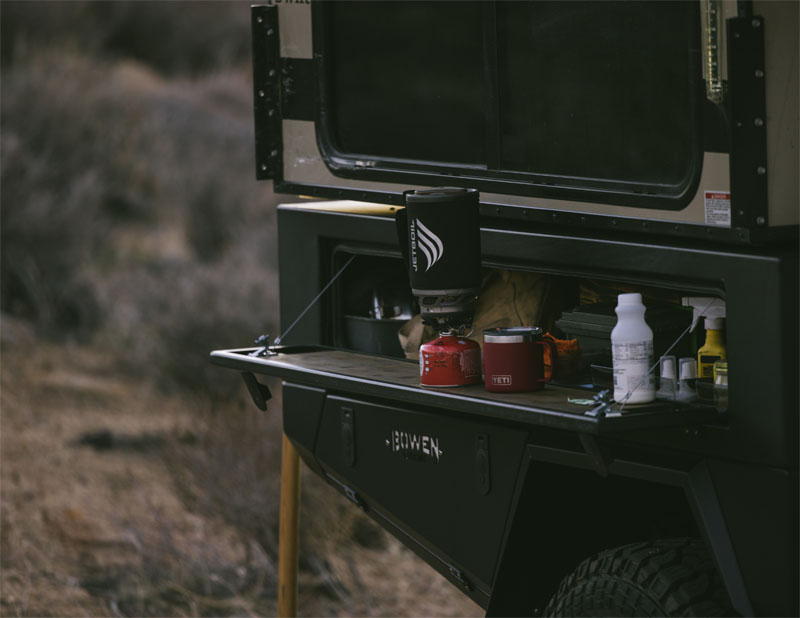
What kinds of gear do customers typically store in your beds?
A lot of times, the passenger’s side becomes a kitchen galley side with a gas burner stove in the upper boxes. Then you have some assortment of cookware, plates, glasses, and non-refrigerated food. That’s typically what we see in the upper boxes. The lower boxes are used for camping gear. We see a lot of air compressors in the lower boxes for easy airing up and airing down. Sometimes customers dedicate a smaller box as a trash bin with a trash bag.
A lot of the time, the driver’s side—as the road side—is dedicated to tools and tool rolls. Anything dirty or muddy—like hiking boots—is often located in the lower boxes to avoid putting these items inside the camper.
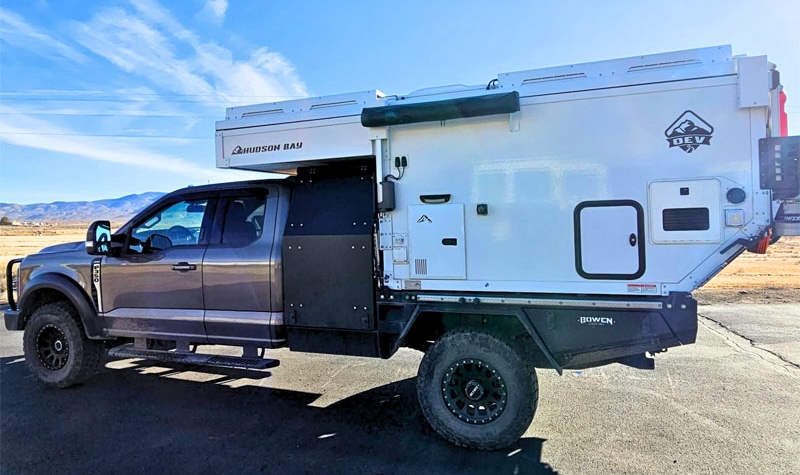
Above: An OEV Hudson Bay pop-up truck camper and Bowen Customs flatbed
When you add garages, the storage gets big fast. For customers with lifted trucks, they’ll put 40 inch spare tires in the garage. In chassis cab models with a garage, it will fit Super Single spare tires up to 44 inches.
For customers without oversized tires, we get a lot of requests for bike slides. Our garages, depending on the size, can fit one, two, three, and sometimes four mountain bikes. For customers into fishing or hunting, the garage is a full pass-through, so you have between 83 to 90 inches of width, depending on the model. We can fit water tanks in the garage for customers who want to do extended travel.
Dan and Marlene of Mali Mish do a lot of Pan American travel. They put a huge fresh water tank in their Bowen Custom garage. We do a lot of stuff like that.
How does someone raise and lower an oversized tire into a Bowen garage?
Some of our customers choose to simply muscle it in and out. For our chassis cab builds, we offer a spare tire assist setup. This consists of a winch mounted inside the garage that can raise and lower the spare in and out of the garage via a ramp attached to the garage opening.
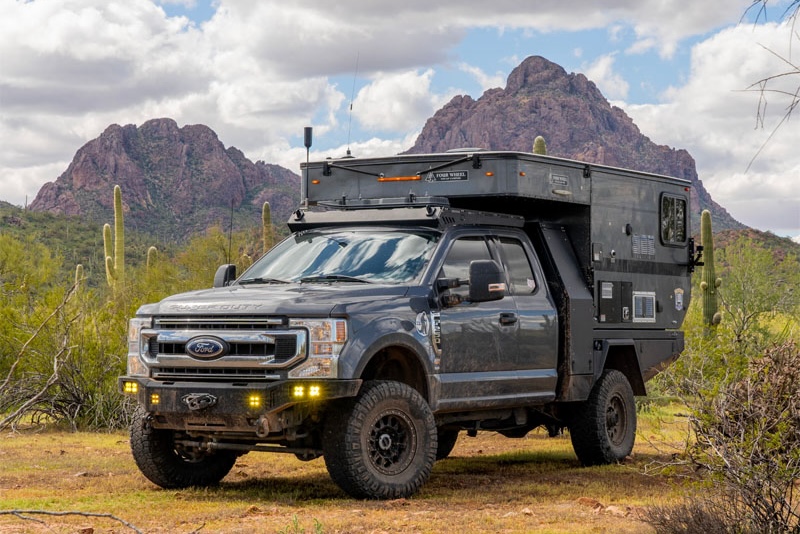
Above: A Four Wheel Camper flatbed and Bowen Customs flatbed with garage
How does a Bowen garage option impact a rig’s center of gravity?
This is part of the fact-finding that we have with our customers. A garage is only suitable for certain truck and camper combinations.
We take a 6.75 foot bed on a full-size Ford, Ram, or Chevy and stretch it to 8 feet. We call that our Stormtrooper build. Some people had a real problem when we first introduced that, but the key is proper application. You wouldn’t put that bed on a truck with a Host Mammoth. But, if a customer has a Hallmark—perfect.
We slid Dan and Marlene’s 8 foot Four Wheel Camper back 18 inches from their Ford F-350 cab. But, their F-350 is very well equipped to handle the weight of that lightweight pop-up truck camper. Most camper companies are also placing water tanks and batteries at the front of the camper. So, the weight distribution is forward.
For the larger campers like Lance and Host, we’ve done weight and balance calculations on the trucks so we know what does and does not work. We know at what point you unload that front axle, which is the real concern with weight distribution. Sometimes we have to flat-out tell them, ‘No, you can’t do that.’
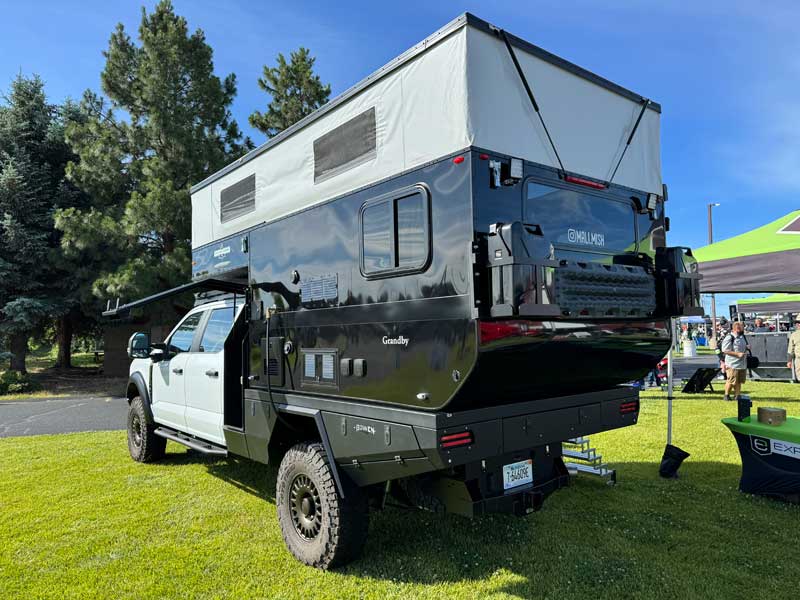
I want to add that we’ll work with anyone and their truck. If someone is in the early stages of planning a truck, camper, and bed combination, even if you don’t buy one of our beds, give us a call at 720-756-2406 and we’ll be happy to coach you on what works and what doesn’t.
Oh boy. You’re going to get some calls. Can items like holding tanks, propane tanks, batteries, or generators be integrated into the bed?
It depends on the specific item and the specific build. For example, Dan and Marlene of Mali Mish had the ability to put a garage on their build, so we could install a large water tank. Had they had a different truck or camper set-up, we might not have had that option.
I’ve seen people put propane and fuel tanks in the boxes. We just did a build with Expedition Overland on their Tundra and, because their truck and topper combination, we designed the refrigerator to slide out the side of the bed. We had the room to do that. We are willing to get creative with our customers.
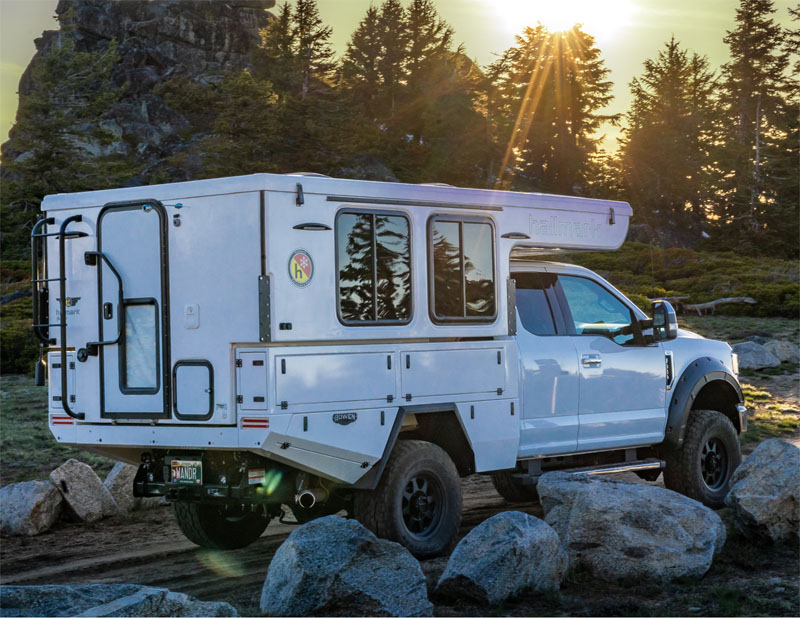
Above: The Hallmark-Bowen “Stormtrooper” rig in action
What are the most popular bed features customers request?
The storage that comes with the bed is the first hugely popular feature. Everybody wants the garage if their truck and camper can accommodate it.
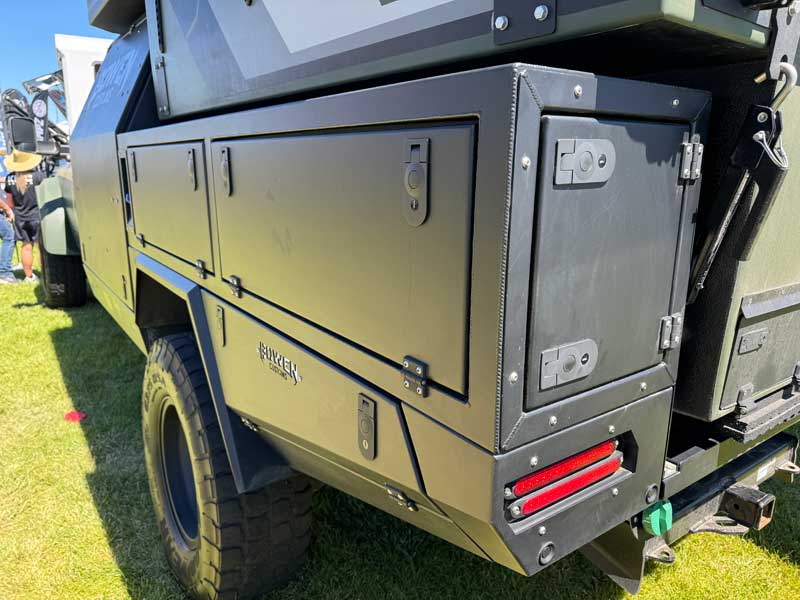
We offer rear upper access doors on our rear upper boxes (shown above and below). That’s above the rear tail lights. That’s handy for fishermen and skiers who need that long storage opportunity. That’s a popular option.

It’s not so much a customer request, but we have camper prep packages that are unique to each camper. It includes our centering wedges, which center your camper when loading and lock it in place. It’s a must have if you have a truck camper. That’s a big one.
For campers with internal tie-downs, we offer inner access doors in our custom boxes so you can reach the tie-down points from the outside. Anyone with a Four Wheel Camper knows you have to be a contortionist to access the internal tie-downs. Those are the kinds of things we do for our customers.
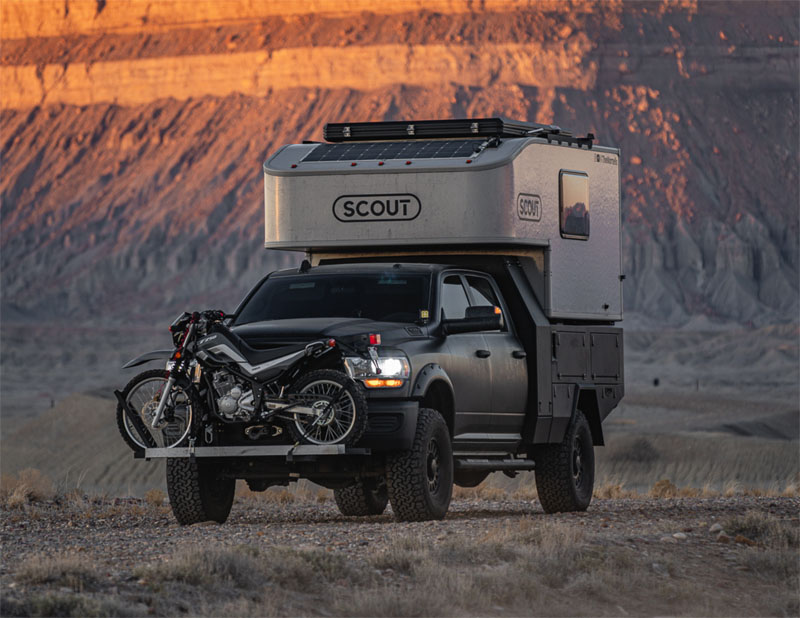
Above: A Scout hard side with a Bowen Customs bed and garage
Who is your typical customer? What kinds of trucks and campers do they have?
We see a lot of one-ton trucks—F-350 and 3500s. That’s a large portion of what we see until you jump up to the Class 4 and Class 5 chassis cabs—F-450s, F-550s, and 5500s.
For campers, we’ve seen them all, but there are definitely the repeat offenders. We see Host all the time. We see Lance all the time. Supertramp is one of the most popular campers that comes through our door. Also, Hallmark, Four Wheel Camper, and Scout. There are definitely customer favorites and those are what I’ve named.
Above: You can book a free build consultation on their website
How does someone order a Bowen bed?
There are a number of ways to get a hold of us. The easiest way is to book a free build consultation on our website under our contact page. You can also call at 720-756-2406 or send us an email at [email protected].
Essentially, we’re going to get on the phone at some point and walk through a lot of the stuff I’ve been mentioning. Whether you have a truck or there’s one you want. Your camper—if you have one or not. What is your goal for your build? We ask about your planned lifestyle with the rig. Are you full-time or a weekend warrior?
We whittle that down and, based on your answers, present you with options and our recommendation. Once we have an idea of what you want, we’ll send you a free estimate. You can get in the build queue by placing a 50 percent deposit. Then, depending on our lead time, we get you in the shop for the install.

Above: Stu at Bowen Customs talks with customers about Bowen beds
How do you talk about pricing with potential customers?
We are very transparent with our pricing. The best way to get a quote or estimate on a build is to jump on a call or schedule a consultation. It’s free and we’ll gladly present all your options and total pricing out the door.
What’s the typical price range—from basic to fully loaded?
A great example of what we do all the time is what’s on Keith and Kelsey’s—the Co-Founders of Supertramp—personal rig. And that’s our 6.75 foot F-350 with our 86 inch camper bed. A number of different campers fit into the back of that build. That bed would be out the door for $21,000 to $25,000, depending on options.
Keep in mind, depending on what you’re building, you can have a bed for as little as $16,000 or it could go north of $50,000. I would feel comfortable saying our average customer is spending between $20,000 to $30,000 with us. It gets into the $30,000 range when you add large options like garages. Our chassis cabs can range between $35,000 and $50,000 typically.
What’s the most expensive you’ve ever built?
We’re working with someone right now who has an almost $60,000 bed order. They’ve already bought a $200,000 EOG Black Edition Ford F-550 and a $125,000 fully-loaded Host. That’s the EarthRoamer customer who just doesn’t want an EarthRoamer.
That’s crazy, but that rig will be a more versatile, demountable EarthRoamer—for half the cost.
At the other end of the spectrum, I had a guy a couple of years ago who bought a brand new Ford F-350 base model for like $40,000. Then he bought a base model flatbed from us for about $17,000 and a base model Four Wheel Camper Hawk. It was roughly $70,000 total for everything, and his rig was as capable as just about anything out there.
What’s your current lead time if someone orders a Bowen Bed today?
It all depends. For production models, we are typically in the five to six month range. For custom builds, we’re more like nine months. When it comes time to install, the average customer drops off their truck and camper on Monday and leaves on Thursday.
How does that work logistically with the customers?
Some people get a local hotel during that time. Others ship their truck to us. Some folks drive their truck to us, fly home, and then fly back.
Tell us about your warranty and how you support out-of-state customers.
For warranty, we believe in the ‘excellence wins’ principle. We bend over backwards to take care of our customers. One principle we live by here is that mistakes happen—it’s what you do about your mistakes that matters. We take care of our customers. Bottom line.
If a customer has a latch failure, for example, we typically drop one in the mail that same day. We had a customer get side-swiped by a truck, damaging the boxes down one whole side. In that instance, we needed the truck brought back to us. We had a bad batch of LED taillights once. Most customers replaced the lights themselves. One went to a local upfitter to have it done.
Our products are aluminum boxes. It’s pretty rare that we have a warranty issue. Our beds are also modular, meaning the boxes can be unbolted from one another should one need to be replaced or repaired, say if it was in an accident.
Do you plan to expand into products beyond truck beds?
It’s tempting at times. However, I don’t feel that we have mastered our current product to the level I would like to. For now, our efforts are bringing more bed product lines to market and always increasing our quality.
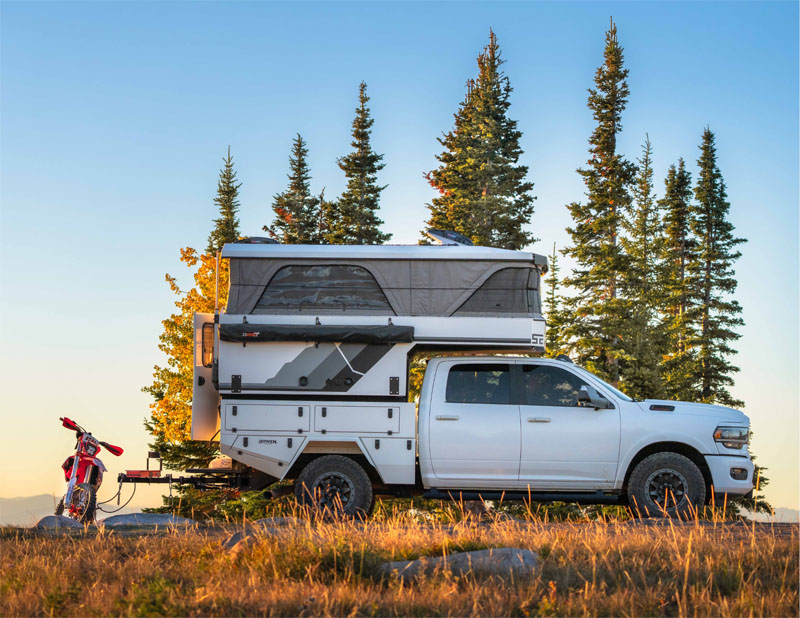
Above: A Supertramp Flagship LT and Bowen Customs bed
Where do you see Bowen Customs in five years?
Our biggest focus at the moment is becoming the best bed manufacturer possible. We are doing that by embracing the principles of lean manufacturing. When you’re constantly increasing your quality and efficiency, and eliminating waste, the company, product, and customer all benefit from that. As we master that process more and more, we’ll be able to bring better products to the market. We’ll be able to provide shorter lead times and an even better customer experience—even though it’s phenomenal already.
When I look five years out, I’m excited by the idea that all of our hard work will have resulted in more people having access to our product—and that we’ve helped more people get out and enjoy camping.
“When I look five years out, I’m excited by the idea that all of our hard work will have resulted in more people having access to our product—and that we’ve helped more people get out and enjoy camping.”
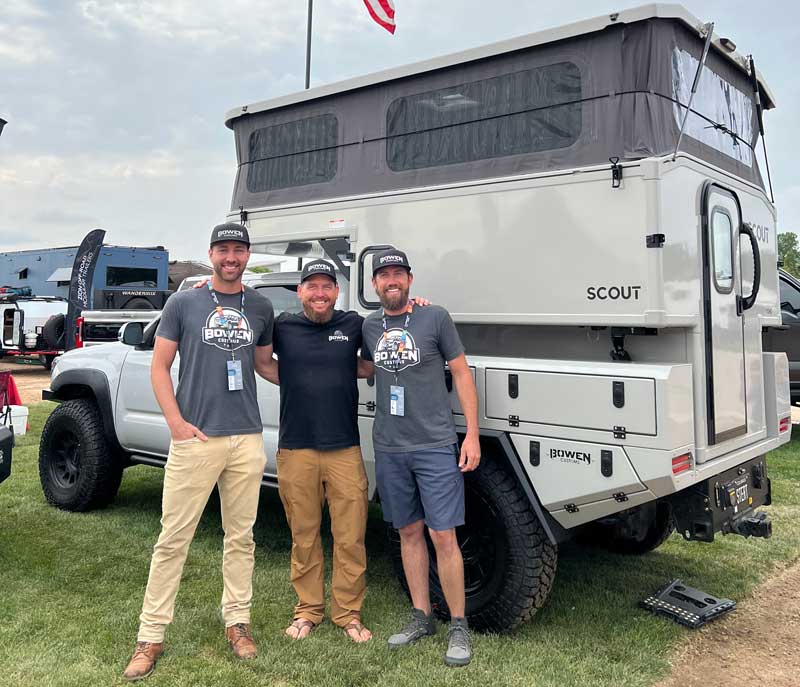
Above: Stu, Brent, and Mat at Overland Expo Mountain West 2025 in Loveland, Colorado
Is there anything else you’d like to share that we haven’t asked?
It’s simple really. We’re a family-owned company in the USA, and we make our products with other families that work and live here in Colorado. We just happen to be really passionate about truck camping and helping people build their perfect rig.
Give us a call! We promise you won’t regret it!
For more information on Bowen Customs, visit their website at bowencustoms.com. To request information on a Bowen Customs bed for your truck camper rig, click here.
